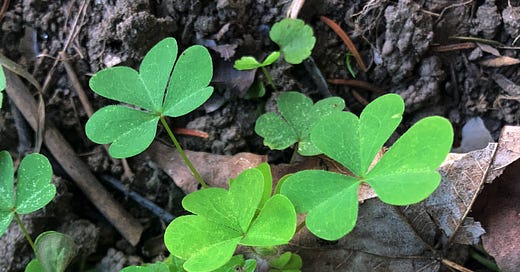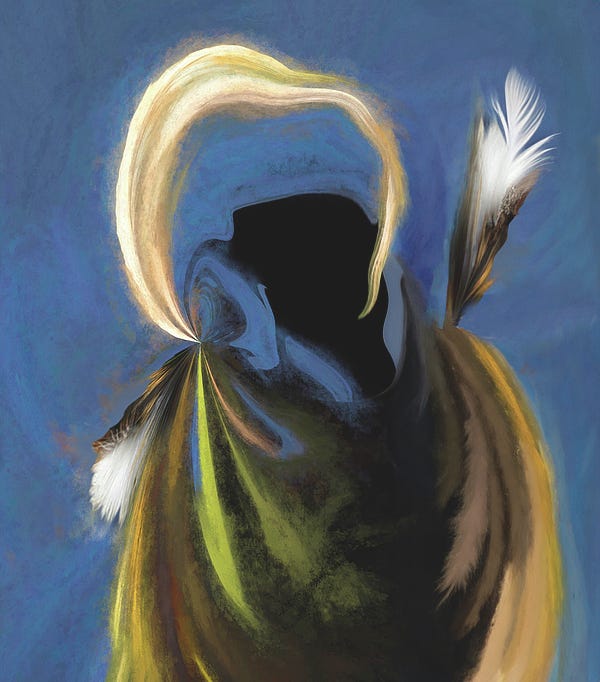A Song of Sorrel - GG Emelia's Sorrel Delights
An indigenous family's quick recipes for soup, salad and garnishing fish and game: Grandma Emelia's Sorrel Sauce and Soup
Chances are that - if you have worked in the garden, lounged with friends in the grass, or spent some time simply observing the greenery around your bare toes - you have stumbled upon one of many different species referred to as Sorrel.
As a child, we always just called it sourgrass. After all, most children don’t memorize the names of plants until some adult inspires them to do so.
I wish I could teleport back to the early days of Grandma Emelia’s life to know if the Abenaki and Iroquois cultures treated those childhood discoveries the same way, though I assume that the wonders of childhood are much the same in their early stages, no matter the culture.
If you are a regular reader you will recall that my GG Emelia, who was Abenaki, and her husband Simeon Roi, who was Iroquois, had 24 children over the course of their lives, 19 of whom survived to adulthood.
Those aware of the historic conflict between the Abenaki and the Iroquois, may find themselves wondering how this unusual relationship developed.
What initially sparked their love for one another appears to be a youth spent in an orphanage, where they grew up. In other words, they probably fell in love despite the long-standing animosity between the Iroquois and the Abenaki, which would have normally created an invisible cultural barrier between them.
If your last name is Roi, Roy or King and you live in Northern NH, Maine, Vermont or New York, it’s likely that you can just refer to me as “Cuz”.
Furthermore, you’ll probably have a genetic propensity for wild foods like Sorrel because our survival surely came from years of consuming dishes with them as garnishes, side dishes, or even entire meals eeked from the bounty of the arms of "Asehwehweh" or “Agaskw”, grandmother earth in Iroquois and Abenaki, respectively.
"Nature,” said John Mohawk, an Iroquois Elder, “is the power of the universe made manifest to humans." We reveled in that power, we were grateful for that power, we worshipped that power, irrespective of age, because it spread its bounty upon us.
Perhaps it is imprinted genetically on my cultural landscape but every spring I watch for Wood Sorrel to begin poking up.
Unlike its woodland companions, the False Hellebore and the Skunk Cabbage that burst out in a flourish of leaves, Wood Sorrel is tiny at first but blossoms into a virtual bouquet of delicate flowers and hearts, in the warmth of the sun and Asehwehweh’s nourishment. It is invariably the first herb I pluck from the ground and pop into my mouth, reveling in the distinctive sour flavor.
Sorrel comes in many shapes and sizes, from the “Wood Sorrel”, a fast-growing, prolific plant, to the lancet-shaped Sheep Sorrel. When it comes to Wood Sorrel, the uninitiated might mistake it for clover, except that it bears a delicate yellow, pink, or white petalled flower - not the globe-like purple or white flowers of clover. The leaves are more heart-shaped than clover.
Now don’t panic about mistaking the two, it won’t hurt you to chew on a sprig of clover, though you may be tempted to “moo” afterwards, because clover is a favorite of the bovine species. Bringing to mind - for no particular reason -one of my favorite childhood poems by Ogden Nash:
“The cow is of the bovine ilk;
One end is moo, the other milk.”
This is all to say . . . clover tastes like, well . . . grass. Sorrel, on the other hand, tastes like a delightful lemony surprise. Some academic publications describe it as a medium-sized “weed” that occurs throughout most of North America, But to the Abenaki it is NO weed. It is a staple.
Even in its early stage - the miniature Wood Sorrel looks the same as the fully grown wood sorrel, just smaller.
If you are among the more academically inclined - those who catalog their plants using scientific classification - the various species of Sorrel are in the Latin family Polygonaceae and in the Genus Rumex and Genus Oxalis.
Within the genus Oxalis, there are several hundred species. Some of which you will undoubtably recognize. A plant called “Sheep Sorrel” looks like an elongated Native Clovis spearhead, with lower protrusions - called auricles - that would have been used to tie the head to the spear. Sheep Sorrel grows on lawns, in pastures and in fields.
While the form taken by the different Sorrels varies from one plant to the next, the flavor is largely the same - varying mostly in degree. The source of the flavor is vitamin C. Native people introduced colonial immigrants to it as a means of preventing or treating scurvy.
Simeon Gideon Roi and Emelia Roi and their family lived an itinerant life. Traveling between Saint Francis, (aka - Odanoc) Quebec, and Whitefield, New Hampshire. As their children grew to maturity they would marry or depart as singles, taking the name of their new spouse or choosing the surname Roi, Roy, or King - seemingly as a final naming ceremony.
Feeding a family on this lengthy journey was surely a challenge. Simeon and those of the children disposed to hunting and fishing, would supply fish and small game. They also fashioned nets to capture crayfish but it was probably much more fun (and fast) to simply bait an area where the water was running more slowly and then by torchlight grab up the “bugs” as they scavenged.
Emilia’s job, with help from her own eager crew, would have been to gather herbs like Sorrel to add some variety and flavor to meals.
A sorrel sauce was a perfect garnish for Salmon, Trout or Bass. They would crush the sorrel, add some water and spices and have a perfect sauce to add zest to their salmon. Or they could simply garnish a salad with bits of Sorrel to make the taste of watercress, dandelion greens and wild onions even more delightful.
On cooler nights, Emelia’s crew might have prepared a sorrel soup, which can be served hot or cold as a side dish.
You can try these out yourself - no mortar and pestle required - if you have a food processor!
So, if you’ve been following the fishing tips of George Liset’s “Writing on the Fly” column, you now have the makings of an entire meal, complete with garnishes and trimmings.
Recipes
Note: I’m not going to suggest that you give up the trappings of a modern kitchen but if you really want to try it, send me an email and I’ll send you off “Emelia’s fireside sorrel soup recipe” for a delicious (but time-consuming) Native alternative.
Simple Sorrel Sauce -Great on fish or poultry
makes about 1.5 cups
3 cups packed sorrel leaves, washed and dried
1/2 cup unflavored Greek yogurt
3 garlic cloves, crushed
3 tablespoons olive oil
1/2 teaspoon Dijon mustard
Salt
Pepper
Blend in food processor and serve
“Frenchified” version (No processor required, but heavy cream is demanded)
2/3 cup heavy cream
3 tablespoons unsalted butter
1/4 pound sorrel leaves, stems removed
2 tablespoons vermouth, or chicken or vegetable stock
Salt and white pepper to taste
Pour the cream in a small pot and bring it to a simmer. (Prevents curdling when added to the sorrel mixture)
In another small to medium pot, heat the butter over medium heat and add the sorrel. Cook the sorrel, stirring often, until it melts and incorporates the sorrel. Stir in the cream and bring the sauce to a bare simmer. Use the vermouth, or stock to thin it out. Add salt and white pepper to taste and serve.
Sorrel Soup
Soup Base
1 small chopped onion (1/2 cup)
1 Tbs. butter or olive oil
1 small clove minced garlic
1 medium baking potato peeled and diced
3 cups water or broth. (or try adding cream for a “Frenchified version”
4 cups sorrel leavesDespite the brightness of the Sorrel, this soup turns a brownish color - akin to pea soup - when cooked - but you can, according to some sources, keep the bright green shade by adding your sorrel as a paste mixed with 2 tablespoons of softened buttter at the very end of the process just before serving.
Sorrel Paste
4 cups sorrel leaves (3 oz./90 g.), stems trimmed
2 Tbs. (1 oz./30 g.) softened butter or olive oilSAUTE the onion or leek in butter or olive oil in a medium saucepan 3 to 4 minutes, or until softened. Stir in the garlic, then add the potato and water. Season with salt and pepper. Cover, and simmer 20 to 25 minutes, or until the potato pieces are very soft.
MEANWHILE, MAKE the Sorrel Paste. Pulse the sorrel leaves in a food processor until finely chopped. Add the butter or olive oil, and process until a smooth paste forms.
PUREE the soup with an immersion blender until smooth, then stir in the sorrel paste. Adjust seasonings, and serve hot or cold. Alternately, add the soup directly to the sorrel paste in the food processor, and blend everything until smooth. Adjust seasonings, and reheat, if necessary.
Notes and links
The history and culture of the Abenaki People
Caribbean “Sorrel”
In the Caribbean, a delicious drink is made from the hibiscus plant and referred to as Sorrel. It’s delicious and refreshing. Try it out. . .
You will often read that Sorrel is related to Rhubarb. It is true and, with respect to the stalks of Rhubarb, the tastes are similar. Just don’t eat the leaves of the Rhubarb, they are toxic.
Your purchases of images from the gallery benefit both the Chronicles and the Podcasts and make it possible to produce them without advertisements.
No room for a new piece of art? All these images are available as cards, mugs, puzzles, shower curtains, phone cases, clothing, totes, and more. Click here for merch.
Peering into the Barn
The Winter Warrior
Paper Birch Milan NH
The Wonderous Lightness of Early Spring
Cloud Forms On The Horizon
Cloud Form Over the Continental Divide
Lafayette Lupine Mindscape
Rushmore Reimagined
Signed Originals
Pink Flowers and a Washline
Maples in the Wind














